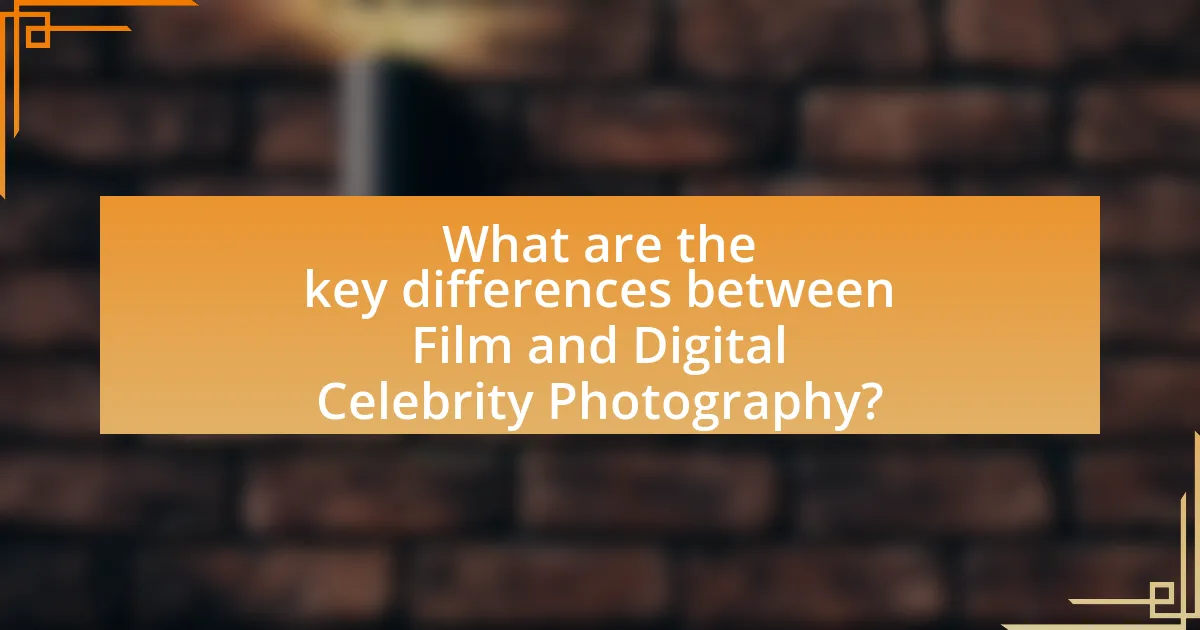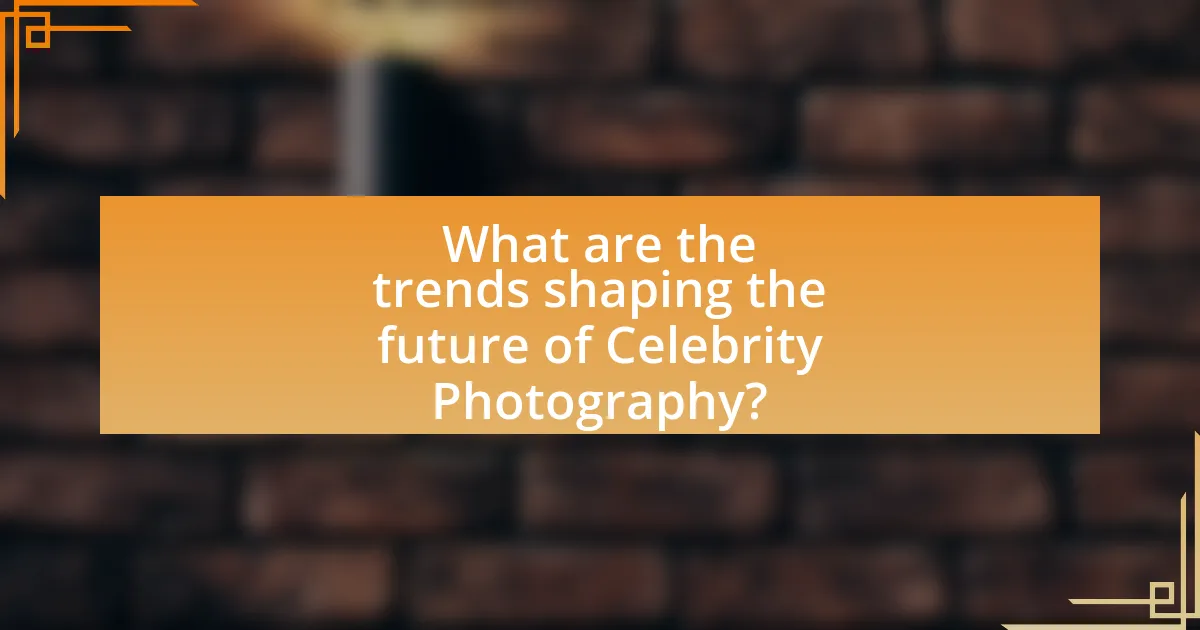The article examines the evolution of celebrity photography, tracing its development from early film-based techniques to contemporary digital practices. It highlights key milestones, such as the transition from black-and-white to color photography, the rise of instant photography, and the impact of digital technology and social media on the industry. The discussion includes the influence of technological advancements on photography styles, the significance of celebrity imagery in popular culture, and the ethical considerations photographers must navigate. Additionally, it explores emerging trends and technologies shaping the future of celebrity photography, including artificial intelligence and virtual reality.

What is the Evolution of Celebrity Photography?
The evolution of celebrity photography has transitioned from early film-based techniques to modern digital practices. Initially, in the early 20th century, celebrity photography relied on black-and-white film, where photographers like Edward Steichen captured iconic images of stars, often using staged settings and dramatic lighting to enhance their subjects. With the advent of color film in the 1930s, photographers began to portray celebrities in more vibrant and realistic ways, reflecting their personalities and lifestyles.
The introduction of instant photography in the 1970s, exemplified by Polaroid cameras, allowed for immediate capture and sharing of celebrity moments, changing the dynamics of public engagement. The digital revolution in the late 1990s and early 2000s further transformed celebrity photography, enabling high-resolution images and instant dissemination through the internet and social media platforms. This shift has led to a more democratized form of celebrity photography, where fans can capture and share images of their favorite stars, blurring the lines between professional and amateur photography.
Overall, the evolution of celebrity photography reflects broader technological advancements and changing cultural perceptions of fame, illustrating how the medium has adapted to the demands of both the industry and the audience.
How has celebrity photography changed over the decades?
Celebrity photography has evolved significantly over the decades, transitioning from film-based techniques to digital formats. In the 1950s and 1960s, celebrity images were primarily captured on film, requiring careful composition and lighting, with photographers like Richard Avedon and Irving Penn setting the standard for high-quality portraits. The introduction of color photography in the 1970s expanded the visual appeal, allowing for more vibrant and dynamic representations of celebrities.
The 1980s and 1990s saw the rise of paparazzi culture, with photographers like Ron Galella capturing candid moments, often leading to legal battles over privacy. The advent of digital photography in the late 1990s and early 2000s revolutionized the industry, enabling instant image capture and editing, which increased the volume and speed of celebrity images disseminated through media outlets and the internet.
Today, social media platforms have further transformed celebrity photography, allowing stars to control their own narratives and share images directly with fans, diminishing the role of traditional media. This shift has resulted in a more personal and immediate connection between celebrities and their audience, fundamentally altering the landscape of celebrity photography.
What were the key milestones in the transition from film to digital photography?
The key milestones in the transition from film to digital photography include the introduction of the first digital cameras in the late 1970s, the development of the first commercially available digital camera by Kodak in 1991, and the widespread adoption of digital photography in the early 2000s. The first digital camera, the Sony Mavica, was released in 1981, allowing images to be stored on floppy disks. Kodak’s DCS 100, launched in 1991, marked a significant advancement as it was the first digital camera aimed at professional photographers. By the early 2000s, digital cameras surpassed film cameras in sales, driven by improvements in image quality, storage capacity, and convenience, leading to a complete shift in the photography industry.
How did technological advancements influence celebrity photography styles?
Technological advancements significantly influenced celebrity photography styles by enabling higher quality images and more creative techniques. The transition from film to digital photography allowed for instant feedback, which encouraged photographers to experiment with lighting, angles, and compositions. For instance, the introduction of digital cameras in the late 1990s provided photographers with the ability to capture images at a higher resolution and manipulate them using software like Adobe Photoshop, leading to more polished and stylized portraits. Additionally, advancements in smartphone technology have democratized photography, allowing celebrities to share candid moments directly with fans, thus shifting the style towards more informal and authentic representations. This evolution reflects a broader trend in the industry where immediacy and accessibility have become key components of celebrity imagery.
Why is celebrity photography significant in popular culture?
Celebrity photography is significant in popular culture because it shapes public perception and influences societal trends. This form of visual media provides a lens through which audiences engage with celebrities, often dictating fashion, lifestyle choices, and social norms. For instance, studies have shown that images of celebrities can lead to increased consumer behavior, with a 2018 report indicating that 70% of millennials are influenced by celebrity endorsements in their purchasing decisions. Additionally, celebrity photography plays a crucial role in the construction of identity and aspiration, as individuals often look to these images for inspiration and validation in their own lives.
What role does celebrity photography play in shaping public perception?
Celebrity photography significantly influences public perception by crafting idealized images that shape societal standards and expectations. This visual representation often highlights glamour, success, and lifestyle, leading audiences to form opinions based on these curated portrayals. Research indicates that exposure to celebrity images can affect self-esteem and body image, as seen in studies published in the Journal of Consumer Research, which demonstrate a correlation between celebrity portrayal and consumer behavior. Consequently, the role of celebrity photography extends beyond mere documentation; it actively constructs narratives that impact how individuals perceive themselves and others in relation to societal norms.
How does celebrity photography impact the careers of public figures?
Celebrity photography significantly enhances the careers of public figures by increasing their visibility and public engagement. This visibility often translates into greater media coverage, which can lead to more opportunities in various fields such as acting, music, and endorsements. For instance, a study by the Pew Research Center found that 72% of Americans follow celebrities on social media, indicating that celebrity photography plays a crucial role in shaping public perception and brand identity. Consequently, public figures who are frequently photographed and featured in media are more likely to secure lucrative deals and maintain relevance in their industries.

What are the key differences between Film and Digital Celebrity Photography?
The key differences between film and digital celebrity photography lie in the medium of capture, processing time, and image manipulation capabilities. Film photography uses chemical processes to capture images on light-sensitive film, resulting in a distinct grain and dynamic range, while digital photography captures images using electronic sensors, allowing for immediate review and editing. Digital photography offers greater flexibility in post-processing, enabling photographers to manipulate images extensively, whereas film requires more careful planning and execution due to its limited exposure and development options. Additionally, digital cameras often provide higher resolution and the ability to shoot in various lighting conditions without the need for extensive equipment changes, making them more versatile for capturing celebrity moments.
How do film and digital photography differ in terms of technique?
Film and digital photography differ primarily in their image capture techniques. Film photography relies on chemical reactions on light-sensitive film to create images, while digital photography uses electronic sensors to capture light and convert it into digital data. In film, exposure is controlled through the aperture and shutter speed, with the development process requiring specific chemicals and time to produce the final image. Conversely, digital photography allows for immediate review and adjustment of settings, with images stored on memory cards and processed using software. This fundamental difference in capturing and processing images highlights the distinct techniques employed in each medium.
What are the advantages and disadvantages of film photography for celebrities?
Film photography offers celebrities distinct advantages and disadvantages. The advantages include a unique aesthetic quality, characterized by rich colors and grain that many find appealing, which can enhance a celebrity’s image. Additionally, film photography often requires a more deliberate approach, allowing for thoughtful composition and moments that can lead to iconic images. On the other hand, the disadvantages involve higher costs and longer processing times compared to digital photography, which can limit spontaneity and accessibility. Furthermore, film lacks the immediate feedback that digital provides, making it challenging for celebrities to quickly assess and adjust their images during a shoot.
How has digital photography transformed the approach to capturing celebrity images?
Digital photography has transformed the approach to capturing celebrity images by enabling instant image capture and editing, which enhances the speed and accessibility of celebrity photography. This shift allows photographers to quickly adapt to changing situations, capturing spontaneous moments that were previously difficult to achieve with film. Additionally, digital technology facilitates high-resolution images and advanced editing tools, allowing for greater creativity and precision in the portrayal of celebrities. The rise of social media platforms has further amplified this transformation, as celebrities and photographers can share images instantly, reaching a global audience without traditional media gatekeepers.
What are the implications of digital technology on celebrity photography?
Digital technology has significantly transformed celebrity photography by enhancing accessibility, immediacy, and the democratization of image creation. With the advent of smartphones and social media platforms, fans and amateur photographers can capture and share images of celebrities instantly, leading to a surge in candid and unfiltered representations. This shift has resulted in a more intimate connection between celebrities and their audiences, as seen in the rise of platforms like Instagram, where celebrities often share personal moments directly with followers. Furthermore, digital editing tools have allowed for greater manipulation of images, raising questions about authenticity and the portrayal of celebrity images in media. The implications of these changes include a shift in public perception, as audiences become more critical of curated images and demand transparency regarding photo editing practices.
How has social media changed the landscape of celebrity photography?
Social media has transformed celebrity photography by enabling direct interaction between celebrities and their audiences, allowing for real-time sharing of images and personal moments. This shift has diminished the gatekeeping role of traditional media outlets, as platforms like Instagram and Twitter allow celebrities to curate their own images and narratives without intermediary filters. For instance, in 2021, a survey indicated that 70% of fans preferred following celebrities on social media for authentic content rather than through traditional media channels. This democratization of celebrity imagery has led to a more personal and immediate connection, fundamentally altering how fans perceive and engage with public figures.
What new opportunities has digital photography created for aspiring photographers?
Digital photography has created numerous opportunities for aspiring photographers, including instant feedback, lower costs, and broader distribution channels. Instant feedback allows photographers to review and adjust their work immediately, enhancing learning and skill development. The reduced cost of digital equipment and the elimination of film processing expenses make photography more accessible, enabling more individuals to pursue it as a hobby or profession. Additionally, digital platforms and social media provide aspiring photographers with the ability to showcase their work to a global audience, facilitating networking and potential career opportunities. These advancements have significantly democratized the field, allowing more voices and perspectives to emerge in photography.

What are the trends shaping the future of Celebrity Photography?
The trends shaping the future of celebrity photography include the rise of social media platforms, the increasing use of artificial intelligence, and a shift towards more authentic and candid imagery. Social media platforms like Instagram and TikTok have transformed how celebrities engage with their audience, leading to a demand for more relatable and behind-the-scenes content. The integration of artificial intelligence in photography tools allows for enhanced editing capabilities and personalized content creation, streamlining the production process. Additionally, there is a growing preference for authentic and candid imagery over highly stylized photos, reflecting a cultural shift towards transparency and vulnerability among public figures. These trends are supported by data indicating that user engagement on social media increases with more genuine content, highlighting the evolving landscape of celebrity photography.
How are emerging technologies influencing celebrity photography?
Emerging technologies are significantly influencing celebrity photography by enhancing image quality, accessibility, and the speed of content creation. Advanced camera systems, such as those found in smartphones, allow photographers to capture high-resolution images with professional-grade features, democratizing the art of photography. Additionally, artificial intelligence tools are streamlining editing processes, enabling faster turnaround times for images. For instance, AI-driven software can automatically enhance photos, reducing the need for extensive manual editing. Furthermore, social media platforms have transformed how celebrity images are shared and consumed, allowing for real-time engagement with audiences. This shift has led to a greater demand for candid and authentic representations of celebrities, as seen in the rise of behind-the-scenes content and live-streaming events.
What role do artificial intelligence and machine learning play in photography?
Artificial intelligence and machine learning significantly enhance photography by automating processes, improving image quality, and enabling advanced editing techniques. These technologies facilitate tasks such as automatic image tagging, facial recognition, and scene detection, which streamline workflows for photographers. For instance, AI algorithms can analyze thousands of images to identify patterns and suggest optimal settings, leading to better exposure and composition. Additionally, machine learning models can enhance image resolution and reduce noise, as seen in software like Adobe Photoshop’s Super Resolution feature, which uses AI to upscale images while preserving detail. This integration of AI and machine learning not only increases efficiency but also empowers photographers to achieve higher creative standards.
How is virtual reality changing the way we experience celebrity photography?
Virtual reality is transforming the experience of celebrity photography by allowing users to engage with images in immersive environments. This technology enables fans to interact with 3D representations of celebrities, creating a more personal and engaging experience compared to traditional 2D photographs. For instance, platforms like Oculus and HTC Vive have introduced virtual galleries where users can view celebrity images and videos in a simulated space, enhancing emotional connections. Research indicates that immersive experiences can increase user engagement by up to 70%, demonstrating the effectiveness of virtual reality in reshaping how audiences perceive and connect with celebrity imagery.
What best practices should photographers follow in the digital age?
Photographers in the digital age should prioritize high-resolution images, effective file management, and consistent branding. High-resolution images ensure quality across various platforms, as digital displays and print media demand clarity. Effective file management, including organized storage and regular backups, protects against data loss and facilitates easy access to images. Consistent branding across social media and portfolios helps photographers establish a recognizable identity, which is crucial in a competitive market. These practices are supported by industry standards that emphasize the importance of quality and organization in professional photography.
How can photographers effectively engage with their audience online?
Photographers can effectively engage with their audience online by utilizing social media platforms to showcase their work and interact with followers. Engaging content, such as behind-the-scenes footage, live Q&A sessions, and interactive polls, fosters a sense of community and encourages audience participation. According to a study by Hootsuite, posts that include images receive 650% higher engagement than text-only posts, highlighting the importance of visual content in capturing audience attention. Additionally, responding to comments and messages promptly builds rapport and trust, further enhancing audience engagement.
What ethical considerations should photographers keep in mind when capturing celebrities?
Photographers capturing celebrities should prioritize consent, privacy, and respect for personal boundaries. Consent is crucial, as obtaining permission from the celebrity before taking their photograph ensures ethical practice and respects their autonomy. Privacy considerations are equally important; photographers must avoid intruding into private moments or spaces, as this can lead to distress for the subject. Respecting personal boundaries involves understanding the context in which the photograph is taken and being sensitive to the celebrity’s comfort level. Ethical guidelines in photography, such as those outlined by the National Press Photographers Association, emphasize these principles, reinforcing the importance of maintaining integrity and professionalism in the field.



